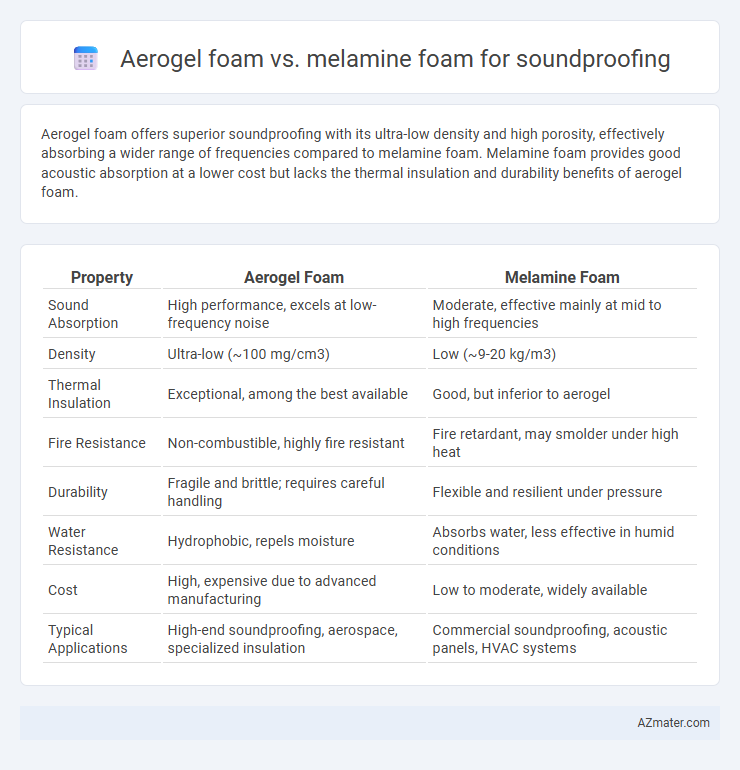Aerogel foam offers superior soundproofing with its ultra-low density and high porosity, effectively absorbing a wider range of frequencies compared to melamine foam. Melamine foam provides good acoustic absorption at a lower cost but lacks the thermal insulation and durability benefits of aerogel foam.
Table of Comparison
| Property | Aerogel Foam | Melamine Foam |
|---|---|---|
| Sound Absorption | High performance, excels at low-frequency noise | Moderate, effective mainly at mid to high frequencies |
| Density | Ultra-low (~100 mg/cm3) | Low (~9-20 kg/m3) |
| Thermal Insulation | Exceptional, among the best available | Good, but inferior to aerogel |
| Fire Resistance | Non-combustible, highly fire resistant | Fire retardant, may smolder under high heat |
| Durability | Fragile and brittle; requires careful handling | Flexible and resilient under pressure |
| Water Resistance | Hydrophobic, repels moisture | Absorbs water, less effective in humid conditions |
| Cost | High, expensive due to advanced manufacturing | Low to moderate, widely available |
| Typical Applications | High-end soundproofing, aerospace, specialized insulation | Commercial soundproofing, acoustic panels, HVAC systems |
Introduction to Soundproofing Materials
Aerogel foam offers superior sound absorption due to its ultra-lightweight and porous structure, providing effective insulation against a broad range of frequencies. Melamine foam, known for its open-cell composition, excels in reducing mid to high-frequency noise, making it ideal for acoustic treatment in offices and studios. Both materials are commonly used in soundproofing applications, with aerogel foam favored for thermal insulation combined with noise reduction, while melamine foam is preferred for cost-effective sound absorption.
What is Aerogel Foam?
Aerogel foam is an ultra-lightweight, highly porous material composed primarily of silica, renowned for its exceptional thermal and acoustic insulation properties. Its nanostructure traps air, reducing sound transmission and making it highly effective for soundproofing applications where minimal thickness and weight are critical. Compared to melamine foam, aerogel foam provides superior sound absorption across a broader frequency range while offering enhanced durability and resistance to moisture.
What is Melamine Foam?
Melamine foam is a lightweight, open-cell material known for its excellent sound absorption and thermal insulation properties, commonly used in acoustic panels and soundproofing applications. Its microporous structure effectively traps and dissipates sound waves, reducing noise and echo in various environments. Compared to aerogel foam, melamine foam offers greater flexibility and cost-effectiveness, making it a popular choice for soundproofing in residential and commercial spaces.
Acoustic Properties: Aerogel vs Melamine Foam
Aerogel foam exhibits superior acoustic absorption due to its ultra-low density and nanoporous structure, effectively dampening a broad range of sound frequencies, especially low-to-mid frequencies. Melamine foam, while lightweight and open-celled, provides excellent sound absorption primarily in the mid-to-high frequency spectrum but lacks the deep frequency attenuation found in aerogel. The thermal insulation properties of aerogel further enhance its soundproofing performance by minimizing sound transmission through temperature-induced air density changes.
Sound Absorption Performance Comparison
Aerogel foam exhibits superior sound absorption performance compared to melamine foam, primarily due to its ultra-low density and nano-porous structure that effectively attenuates a broad range of sound frequencies. Melamine foam, while lightweight and fire-resistant, typically provides moderate sound absorption but lacks the enhanced acoustic insulation properties of aerogel foam in high-frequency attenuation. Studies show that aerogel foam achieves higher Noise Reduction Coefficient (NRC) values, making it a more efficient material for advanced soundproofing applications.
Thermal Insulation Capabilities
Aerogel foam offers superior thermal insulation capabilities compared to melamine foam due to its ultra-low thermal conductivity, often as low as 0.013 W/m*K, making it one of the best insulating materials available. Melamine foam, while effective for sound absorption and fire resistance, has a higher thermal conductivity typically around 0.035 W/m*K, resulting in less efficient thermal insulation. This distinct difference makes aerogel foam more suitable for applications requiring both soundproofing and enhanced thermal barrier performance.
Durability and Lifespan
Aerogel foam offers superior durability and a longer lifespan compared to melamine foam, maintaining its structural integrity and acoustic performance in various environmental conditions. Its resistance to moisture, fire, and compression helps it outperform melamine foam, which tends to degrade faster under similar stresses. Aerogel's robust material properties make it a preferred choice for long-term soundproofing applications requiring consistent performance.
Safety and Environmental Impact
Aerogel foam offers superior fire resistance and non-toxic properties, making it a safer choice for soundproofing compared to melamine foam, which can release harmful gases when burned. Aerogel's lightweight, non-combustible composition results in minimal environmental impact during manufacturing and disposal, while melamine foam's production involves formaldehyde-based resins and generates more waste. Both materials provide effective acoustic insulation, but aerogel foam stands out for enhancing indoor air quality and sustainability in soundproofing applications.
Cost Analysis: Aerogel vs Melamine Foam
Aerogel foam exhibits a significantly higher cost compared to melamine foam, often priced up to ten times more per cubic foot due to its advanced nano-porous structure and superior thermal and acoustic insulation properties. Melamine foam offers a cost-effective solution for soundproofing applications, typically costing between $1 to $3 per square foot, whereas aerogel foam can range from $15 to $50 per square foot depending on thickness and manufacturer. The choice between aerogel and melamine foam ultimately depends on budget constraints and performance requirements, with melamine foam favored for affordability and aerogel for high-performance sound and thermal insulation despite its premium price.
Choosing the Best Foam for Soundproofing Applications
Aerogel foam offers superior thermal insulation and excellent sound absorption due to its ultralight, porous structure, making it ideal for high-performance soundproofing in industrial and specialized environments. Melamine foam excels in noise reduction with its open-cell structure, providing effective acoustic treatment in commercial and residential applications at a lower cost. Choosing the best foam depends on budget constraints, desired acoustic performance, and specific application requirements, with aerogel favored for premium insulation and melamine preferred for versatile, cost-effective soundproofing.

Infographic: Aerogel foam vs Melamine foam for Soundproofing
 azmater.com
azmater.com